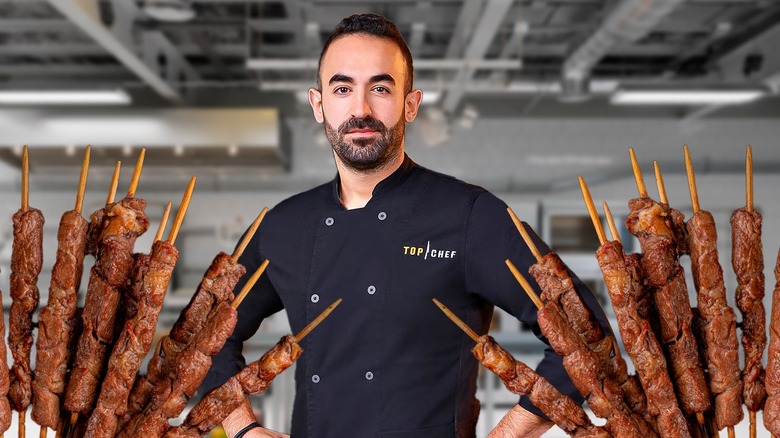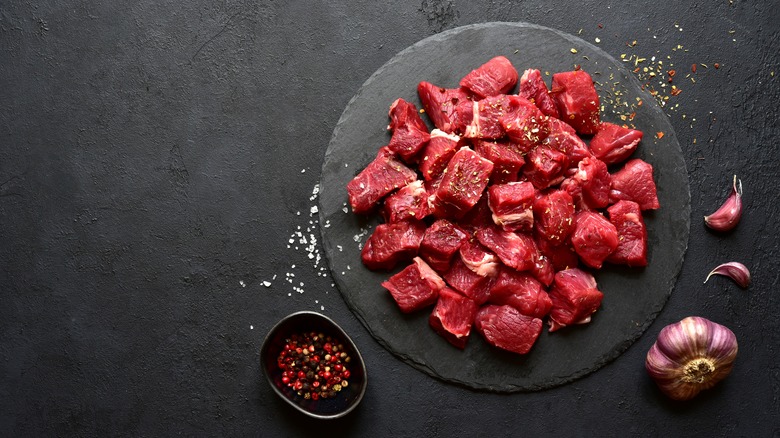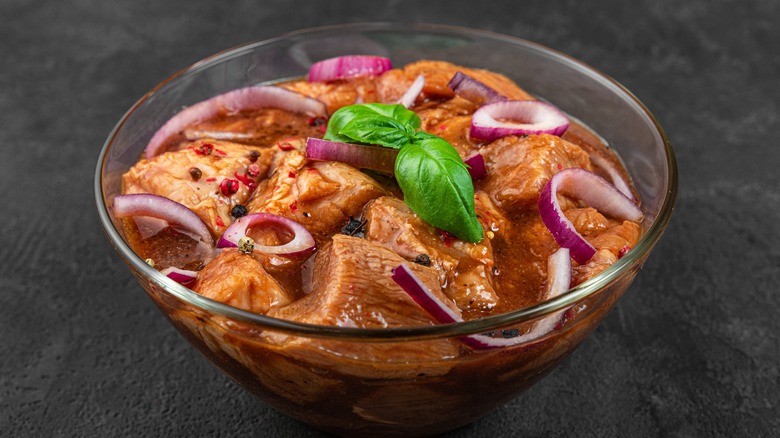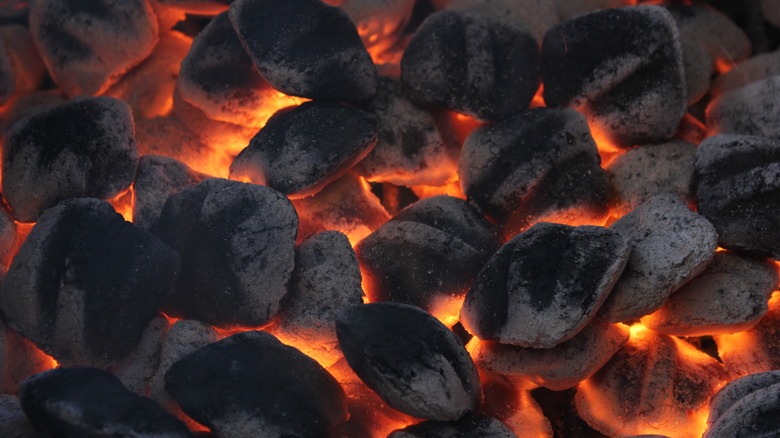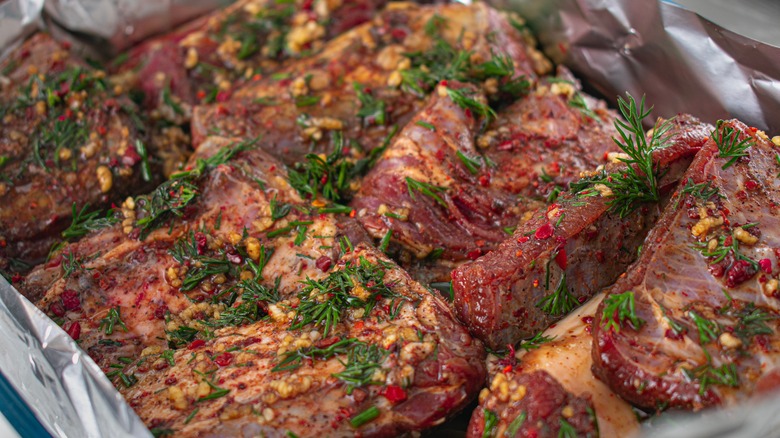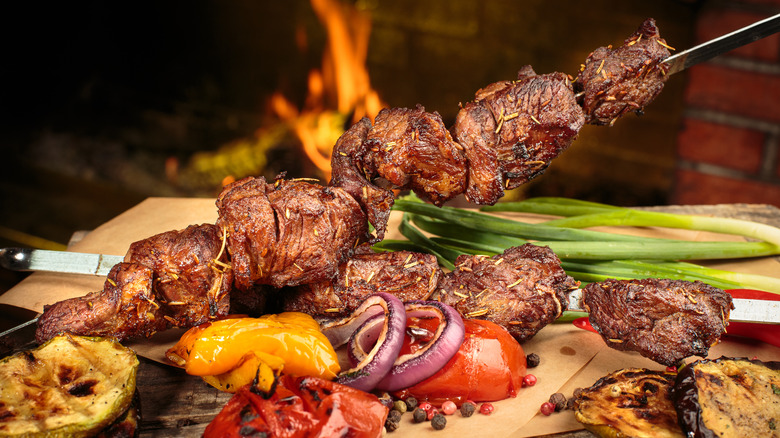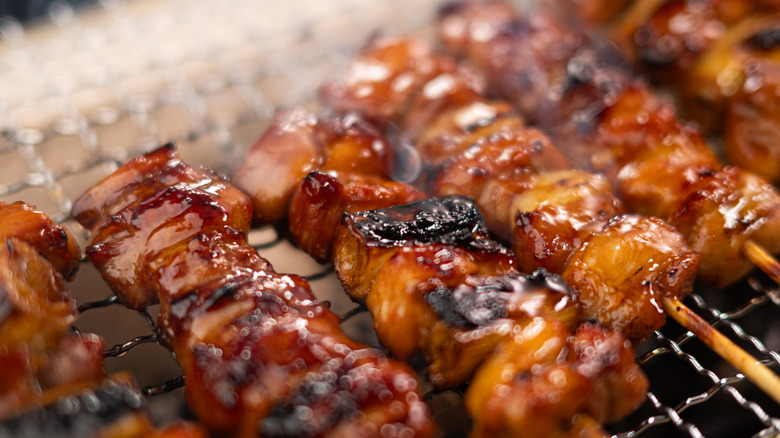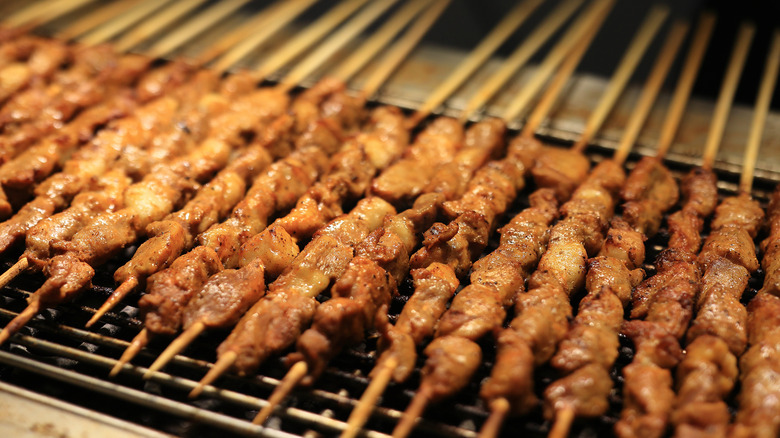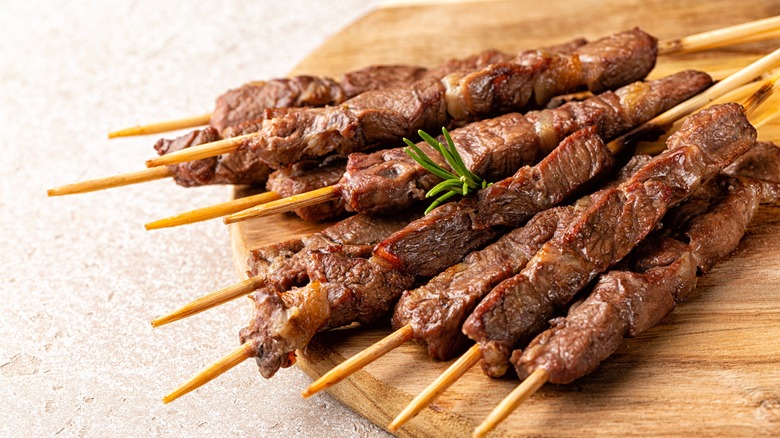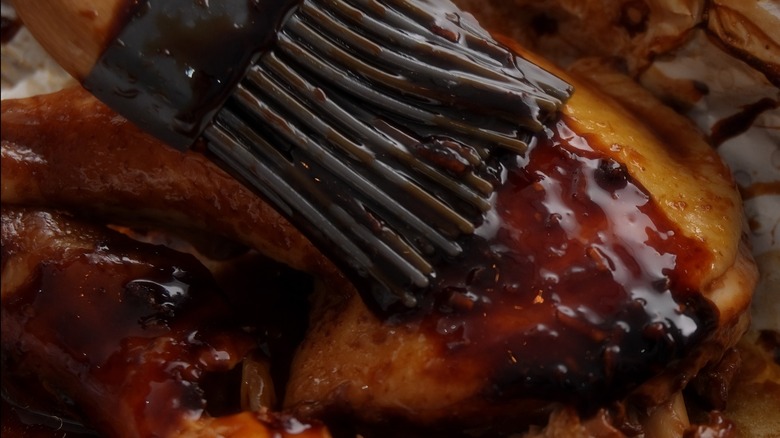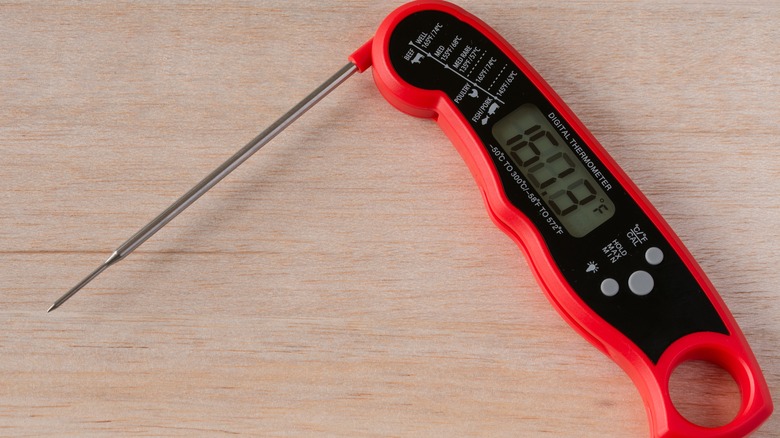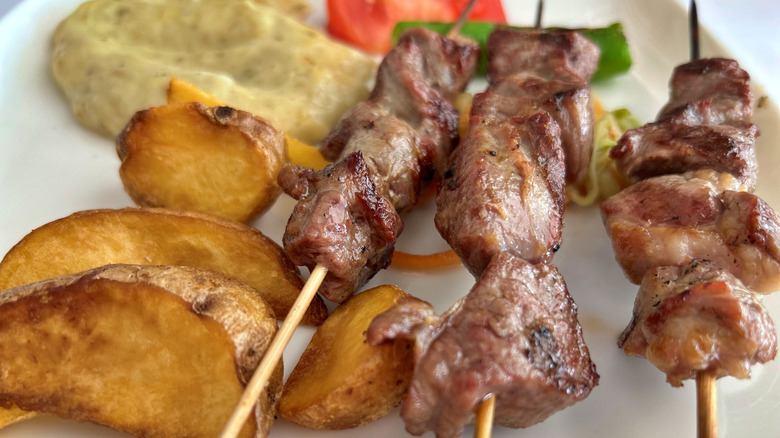Top Chef Winner Charbel Hayek's Best Tips For Grilling Lamb Skewers
Summer is the season for grilling. While no one will deny the tastiness of a burger, smothered in cheese and topped with ketchup and mustard, or a quintessential American hot dog, there's another protein that you should be turning towards for a more sophisticated and flavorful dining experience: lamb. Lamb kebabs are brimming with moisture and flavor, and they taste especially delicious when paired with Mediterranean spices, fresh vegetables, and bright, punchy sauces.
To find out more on how to prepare and grill the perfect lamb skewers, we consulted with "Top Chef" winner Charbel Hayek. Hayek hails from Lebanon and has made a name for himself cooking Eastern Mediterranean fare. He is now the executive chef at two California restaurants: Ladyhawk in West Hollywood and Laya in Hollywood. So, fire up the charcoal, grab yourself a package of skewers, and find out how to whip up the grilled meat that will make you rethink settling for ho-hum burgers and hot dogs ever again.
Select a flavorful cut for your lamb kebabs
Your lamb kebabs are a work of art. Therefore, it's important to set yourself up for success when making them by selecting a quality piece of meat. "Go with cuts that have so many flavors," chef Charbel Hayek recommends. While he notes that many people will go for the lamb tenderloin to make their kebabs, there are other cuts that work just as well, including the shoulder or the lamb leg. Noting that the latter cuts have "a bite" to them, he says, "But [it is] super delicious and packed with so much flavor."
Each one of these different cuts of meat has its merits. For example, if you opt for a boneless leg of lamb, you will have to do some work to remove some (not all, as Hayek indicates) of the excess fat and cut it up into 1-inch pieces to fit snugly on your skewers. When in doubt, you can always ask your butcher for their recommendation on which cut is best to work with, as well as how to properly slice your meat up for the skewers.
Bring your meat up to room temperature before you put it on the grill
Although you'll be grilling your lamb at a rather high temperature, the temperature of your meat when you toss it on the grill plays an important role in how it cooks. Charbel Hayek recommends pulling your kebabs out of the fridge about an hour before you plan on firing up your grill. While this simple tip might require some foresight, it will yield more flavorful and juicier kebabs.
Plopping cold meat, especially tender cuts like the tenderloin, on the grill will cause the moisture inside of the meat to leak out rather than stay wrapped up tight in the muscle fibers. When the moisture leaks out, you'll see that your kebabs become remarkably smaller than when you initially assembled your skewers. Likewise, cold meat on a hot grill equals uneven cooking. Since your grill is so hot, the outside will cook faster than the inside. Bringing your meat up to room temperature will ensure that all parts of the kebab start on an equal playing field temperature-wise, which will ensure a perfectly soft, medium interior and crispy outside.
Opt for charcoal briquettes for the best flavor
There are seemingly endless options for grilling out there nowadays. Not only do you have your fancy schmancy gas-powdered and wood pellet grills, but you also have the humble charcoal grill — the latter of which Charbel Hayek recommends using for grilling your kebabs with. He prefers to use charcoal briquettes because they're natural, which will give your kebabs an amazing flavor. The chef recommends methodically layering the un-heated charcoal briquettes atop the warm, lit ones to get the fire going. After about 40 minutes, the grill is ready to cook with.
There are some important safety steps that you should keep in mind when working with charcoal briquettes, regardless of what you're cooking with them. For one, you should skip the lighter fluid when firing up the grill because it can be toxic if there is any residue left on your food. Instead, turn to materials like crumbled newspaper or cardboard to help get your charcoal briquettes rolling so that you're ready to grill.
Keep your lamb kebab marinade simple
Whipping up a marinade is a great first step to imbuing your kebabs with a ton of flavor. But Charbel Hayek recommends keeping this rather simple and straight to the point. His go-to lamb kebab marinade is made with a mixture of yogurt, lemon and orange juice, sherry vinegar, kebab spice mix, oil, and salt, which he lets sit with the meat for about two hours before it's time to start grilling.
The key to building an effective marinade is to have a balance of acidic ingredients, as well as seasonings. In order to pair a marinade with a cut of meat, you'll need to consider how tender it is, as well as how much fat it has. The acidic elements in the marinade, which in Hayek's case includes the yogurt, citrus juice, and vinegar, will complement any sort of residual fat on the meat and add to the flavor.
The salt is also an important component to the marinade because it permeates into the muscle tissue and helps soften it. As for the kebab spice mix, expect to see warming spices like cumin, cinnamon, garlic powder, and coriander pop up. It's important that you read the label on your spice mix to see if it already contains salt before you go at it with your salt grinder. Adding too much salt can have negative complications on your meat's texture — and also make it far too salty to enjoy.
For optimal presentation, select metal skewers
Metal or wood, that is the question — at least when it comes to selecting a skewer for your meat. Each type has its merits. Metal skewers tend to be thicker, and each time you rotate the skewers on the grill, you'll find that the meat won't shift or become as dislodged as easily as if you used a round, bamboo one. But you will also end up having to wash or clean them after you're done. Bamboo skewers tend to run cheaper because they're disposable, but you'll have to be careful to keep a pair of tongs nearby, since many wooden skewers aren't long enough to safely rotate by hand.
Another factor that you should consider when selecting your skewers, especially if you plan to serve the meat directly from them, is the presentation. "I like to serve a large metal skewer showcasing the meat," Charbel Hayek explains.
If you're grilling with wooden skewers, soak them beforehand
Another one of the drawbacks to using wooden skewers instead of metal ones is that you have to factor in the time to adequately soak them before you toss them on the grill. "It's super necessary to soak the wood skewers for a couple hours before use," Charbel Hayek says. "If you don't, the skewers will burn, and the meat will fall on the grill."
If you don't want all of your hard, kebabbing work to go to waste, be sure to drop your skewers in water for at least 30 minutes, preferably upwards of a few hours, per Hayek's suggestion. Granted, you won't want to leave them in the water overnight, as this can cause structural integrity issues and cause your skewers to break — wood is porous, after all. Once you pull your skewers from the liquid, leave them to drain on a paper towel for about five minutes before you start sticking them with your hunks of lamb.
Play with direct and indirect heat for the best color on your kebabs
Grilling lamb requires some attention to detail, as well as an understanding of where the hot spots are on your grill. Charbel Hayek notes that the heat mapping and cooking process is not a one-size fits all; some types of proteins require different placings than others. "For example, kafta skewers have to be cooked over low and indirect heat for a couple minutes, then placed right on the grill over high heat to give it a nice color and more flavor," he explains. In comparison, Hayek cooks his Wagyu beef kebabs directly over the fire throughout the duration of the, albeit short, cooking process.
In general, you'll want to stick to cooking your lamb indirectly until you're ready to get that signature char on the outside of the meat. To develop these heat zones on your grill, you can move the charcoal briquettes around or use multiple burners. Moreover, it's important to be mindful of how long you're cooking your kebabs in each spot, as cooking them too long may render the meat tough, rather than juicy and medium — as Hayek prefers to serve his lamb skewers.
Always rest your skewers before slicing into them
If you want to maximize the flavor of your meat and preserve its juiciness, your best bet is to try and stave off the desire to slice your meat as soon as it comes off the grill. Charbel Hayek recommends waiting at least five minutes to slice into your kebabs. "I follow a basic and simple rule, rest the meat for the same time you cooked it," he says. "That's applied to beef, lamb, pork, chicken, and even fish. It's a key factor to have juicy and tender meat."
There are several reasons why you should let the meat rest after cooking it. When the meat is able to cool down for even a brief period, then the muscle fibers can wrap around that juice and keep it contained. Otherwise, you'll risk a dry, tough cut — which can spell disaster for kebabs.
You won't need to apply a glaze if you start with a flavorful marinade
It's not uncommon to glaze certain cuts of meat. It's different than a marinade; the latter is applied before the cooking process begins so it seeps deeper down into the muscle fibers and flavors the meat. While the marinade imparts flavor to all parts of the cut, the glaze sticks to the outside of the meat and creates a syrupy, sticky coating — like on barbecue chicken.
Charbel Hayek notes that you don't have to add a glaze to your lamb while it's grilling. "At Laya, we don't glaze the skewers with anything while they're cooking, because all our meat is already marinated before cooking," he says. "We just finish it with some Maldon salt before serving." Maldon salt has giant crystals, which will not only give your lamb a stunning look, but also a crunchy, unique mouthfeel when you bite into the pieces.
Get an accurate internal temperature reading before you pull the lamb from the grill
When asked about the secret to keeping the meat moist on the grill, Charbel Hayek explains, "There is no secret here, it's simply cooking just enough to keep all the juices and flavor in it." Being able to visually identify when your meat is ready to be pulled from the grill is a skill, but an internal temperature probe is a handy tool that should be used to cross-verify, regardless of your experience. This quantitative measurement will help ensure that your meat is perfectly cooked and safe to consume.
"For me, the perfect internal temperature for the lamb is medium at 130 to 135 F," Hayek says. However, the USDA deems 145 F to be the safe cooking temperature for lamb chops, steaks, and roasts. Ground, minced lamb should be cooked until 160 F. The USDA also recommends a three-minute rest minimum on the meat to ensure that the inside of the kebabs is fully cooked.
Get creative with serving your lamb kebabs
Once your lamb kebabs are removed from the grill, you can get to pairing them with other food. Chef Charbel Hayek serves both lamb and beef kebabs with a tomato chili and lemon tahini sauce. The cooling elements of the sauces complement the succulent, grilled meat quite well.
Another option for grilling would be to intersperse your kebabs with vegetables. For extra juicy results, be sure to place your veggies and your meat methodically on the skewers. If they're packed too close together, you won't get an even cook. But if you leave too large of a gap between your pepper slices, onions, and lamb, you won't get the most bang for your buck when it comes to skewer space. You'll also want to stick items with similar cooking times on the same skewer to prevent over- or under-cooking. Depending on the thickness of your lamb pieces, you may be able to stick thin veggies on the same stick.
